A slip ring switch provides continuous electrical connection through rotating parts, ideal for applications requiring uninterrupted power or signal transfer, while a rotary switch allows selection among multiple circuits by rotating a knob to different positions. Understanding the differences can help you choose the right switch for your project needs--read on to explore their features and applications in detail.
Comparison Table
| Feature | Slip Ring Switch | Rotary Switch |
|---|---|---|
| Function | Transmits electrical signals or power from a stationary to a rotating structure | Selects one or more electrical circuits through manual rotary motion |
| Rotation Type | Continuous 360deg rotation | Indexed rotation with defined positions |
| Application | Used in rotating machinery, wind turbines, robotics, and slip ring assemblies | Used in control panels, measurement instruments, and channel selectors |
| Contact Type | Brushes and conductive rings (slip rings) | Mechanical contact wipers across discrete terminals |
| Signal Type | Can transmit power, analog/digital signals, and data | Switches electrical circuit paths, typically power or signal switching |
| Durability | Designed for high rotational cycles with minimal wear | Limited cycles based on mechanical switching |
| Cost | Generally higher due to specialized design and continuous rotation ability | Lower cost, simpler mechanical design |
Introduction to Slip Ring Switches and Rotary Switches
Slip ring switches enable continuous electrical connection between stationary and rotating parts, commonly used in applications requiring 360-degree rotation such as wind turbines and robotics. Rotary switches provide discrete position switching by rotating a contact arm to different terminals, ideal for selecting multiple circuits or settings in control panels and audio equipment. Both devices serve distinct roles in electrical systems, with slip rings supporting uninterrupted power transmission and rotary switches facilitating manual circuit selection.
Key Differences Between Slip Ring Switches and Rotary Switches
Slip ring switches enable continuous rotation by maintaining electrical continuity through conductive rings and brushes, while rotary switches select discrete electrical circuits by rotating a shaft connected to different contacts. Slip ring switches are ideal for applications requiring uninterrupted power or signal transfer during rotation, such as wind turbines or slip ring motors, whereas rotary switches are commonly used for circuit selection in control panels and electronic devices. The primary difference lies in slip rings facilitating continuous rotation and power transmission, whereas rotary switches provide stepped, non-continuous switching between circuits.
How Slip Ring Switches Work
Slip ring switches operate by maintaining continuous electrical connections between stationary and rotating components through conductive rings and brushes, allowing seamless signal or power transmission during rotation. Unlike rotary switches that change circuits by physically aligning different contacts, slip rings enable 360-degree rotation without interrupting the current flow. This design is essential in applications requiring unbroken electrical continuity in rotating systems such as wind turbines, electric motors, and rotary sensors.
How Rotary Switches Operate
Rotary switches operate by rotating a spindle to connect different sets of contacts, allowing for multiple circuit selections within a single device. Each position on the rotary switch aligns internal contacts to complete a specific electrical path, enabling precise control over your device's functions. This mechanical operation provides reliable and customizable switching in complex control panels or equipment.
Applications of Slip Ring Switches
Slip ring switches are widely used in applications requiring continuous rotation while transmitting power and signals, such as in wind turbines, robotics, and rotating radar antennas. These devices enable the transfer of electrical currents and data from stationary to rotating parts without interruption, making them ideal for slip ring assemblies in industrial machinery and medical imaging equipment. Their design supports high-speed rotation and complex multi-circuit connections, differentiating them from rotary switches primarily used for signal selection rather than continuous rotation.
Common Uses for Rotary Switches
Rotary switches are commonly used in applications requiring the selection of multiple electrical circuits, such as in radio tuning devices, multi-speed fans, and audio equipment for selecting different sound sources. Their ability to handle a higher number of positions with precise mechanical feedback makes them ideal for complex control panels and instrument settings. Unlike slip ring switches, which are often used for transmitting power or signals in rotating assemblies, rotary switches excel in user-driven position selection in stationary devices.
Advantages of Slip Ring Switches
Slip ring switches provide continuous electrical connection during rotation, eliminating signal interruption and allowing seamless transmission of power or data. Their ability to handle high-speed rotations and support multiple circuits simultaneously offers superior performance in dynamic applications. You benefit from increased reliability and reduced wear compared to rotary switches, which rely on discrete contact points prone to sparking and mechanical failure.
Benefits of Rotary Switches
Rotary switches offer precise multi-position selection, making them ideal for applications requiring distinct circuit control in a compact design. They provide reliable mechanical feedback and maintain stable contact through multiple switching cycles, ensuring long-lasting durability. These switches excel in environments where accurate user input and clear position indication are critical for system performance.
Choosing Between a Slip Ring Switch and Rotary Switch
Choosing between a slip ring switch and a rotary switch depends on the specific application requirements for electrical continuity and rotation. Slip ring switches are ideal for transmitting power and signals in devices requiring continuous rotation, such as wind turbines or robotics, whereas rotary switches excel in selecting discrete circuits in stationary positions like control panels. Your decision should consider factors like rotational speed, signal type, and environmental conditions to ensure reliable performance.
Conclusion: Which Switch Suits Your Needs?
Slip ring switches excel in applications requiring continuous rotation with seamless electrical contact, ideal for devices like wind turbines or robotics. Rotary switches offer precise position control and multiple circuit options, fitting well in control panels or audio equipment. Your choice depends on whether you need uninterrupted rotation or discrete position control for your specific use case.
slip ring switch vs rotary switch Infographic

 solderic.com
solderic.com